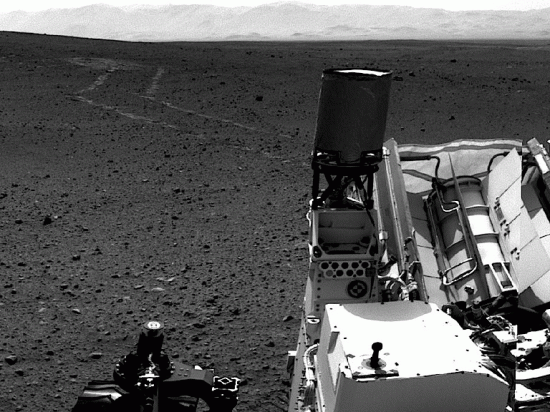Sep 07, 2012
The Mars Science Laboratory has begun its journey to Mount Sharp
Mars is composed mostly of iron and silicon, with massive quantities of oxygen bound into the soils and bedrock. Although quite a bit like Earth’s geology in some respects, the Martian crust is low in aluminum, one of the most common elements on our planet. Since the atmosphere on Mars is so thin, sometimes described as standing on top of a mountain six-times higher than Everest, it lacks the ability to aggressively erode the Martian lithosphere.
On Earth, water vapor in the atmosphere forms a weak carbonic acid solution when it mixes with carbon dioxide, and that helps to wear away the rocks. On Mars, such erosion is impossible for several obvious reasons, not the least of which is that there is no open water on Mars or in its atmosphere.
The presence of iron oxide in many different forms indicates that something once took place on Mars that is not taking place today. Some speculate that there was once a dense, oxygen-rich atmosphere that allowed for “rusting” of the iron in its crust to take place.
Others have said that there were oceans of open water on the surface that helped to form the hematite nodules in their trillions that cover nearly a whole hemisphere (perhaps more). Whatever the source, Mars has hematite dunes a kilometer high, giant cracks that go on for hundreds of kilometers with their bottoms covered in hematite ripples, seas of hematite dust tens of meters deep swallowing craters a hundred kilometers in diameter – many of them associated with slabs of silicon dioxide.
Curiosity will explore Mount Sharp along one of two paths, analyzing soil samples with a variety of instruments. Each trail follows channels that meander down the mountain, presumably because they were formed by liquid water runoff at some time in the distant past. Mount Sharp itself is thought to be a collection of “wind-delivered sediments subsequently soaked by groundwater,” so mission specialists are hoping that it will provide the traces of biology that the Viking landers did not.
If it were possible to take a deep breath on Mars, one thing that would be instantly noticeable is the odor of spent gunpowder or a burned match head. Mars contains rich deposits of sulfur. Sulfur was first detected on Mars in 1976 by the twin Viking landers. Chrsye Planitia and Utopia Planitia revealed a remarkable similarity between soil samples from the two sites, despite being more than 6000 kilometers apart. Vikings 1 and 2 detected sulfur compounds of up to 3% by weight in the fine dust.
The majority of the sulfur on Mars is bound up with iron and magnesium into sulfates that seem to indicate a “long soak in water”. According to mission specialists, the magnesium sulfate accumulation indicates that the mineral either formed in the presence of water or remained submerged for a long time after formation. Since Mars was presumed to be a wet planet at some time in its past, the sulfates have provided theorists with potential confirmation.
Curiosity’s instruments include atmospheric pressure analyzer, temperature, humidity, and wind sensors, along with ultraviolet radiation detectors. The Russian Federal Space Agency supplied an instrument to measure subsurface hydrogen up to 1 meter below the surface. Finding hydrogen could indicate the presence of water ice or water bound in minerals.
Recently, NASA investigators announced that they have detected “non-thermal radiation” from the Martian surface. Since the energy readings were independent of the surface temperature, and occurred during one of the giant dust storms that sometimes rage through the southern plains, the assumption is that they are evidence for lightning discharges.
NASA scientists often refer to what they find on Mars as “mysterious” or “puzzling” with long years of research and contemplation ahead of them. We predict that the reason for the confusion is the problem of reverse application. Earth should not be used to explain the Solar System. The geological patterns found elsewhere deserve alternative viewpoints.
Stephen Smith













